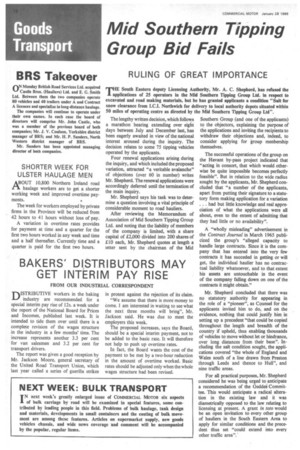Mid Southern Tipping Group Bid Fails
Page 18

If you've noticed an error in this article please click here to report it so we can fix it.
South Eastern deputy Licensing Authority, Mr. A. C. Shepherd, has refused the 'THE South
of 25 operators in the Mid Southern Tipping Group Ltd. in respect to excavated and road making materials, but he has granted applicants a condition "Salt for snow clearance from I.C.I. Northwich for delivery to local authority depots situated within 50 miles of operating centre as directed by the Mid Southern Tipping Group Ltd".
The lengthy written decision, which follows a marathon hearing extending over eight days between July and December last, has been eagerly awaited in view of the national interest aroused during the inquiry. The decision relates to some 75 tipping vehicles operated by the applicants.
Four renewal applications arising during the inquiry, and which included the proposed variation, attracted "a veritable avalanche" of objections (over 60 in number) writes Mr. Shepherd. The renewal applications were accordingly deferred until the termination of the main inquiry.
Mr. Shepherd says his task was to determine a question involving a vital principle of considerable moment to road hauliers.
After reviewing the Memorandum of Association of Mid Southern Tipping Group Ltd. and noting that the liability of members of the company is limited, with a share capital of £2,000 divided into 200 shares of £10 each, Mr. Shepherd quotes at length a letter sent by the chairman of the Mid Southern Group (and one of the applicants) to the objectors, explaining the purpose of the applications and inviting the recipients to withdraw their objections and, indeed, to consider applying for group menbership themselves.
The successful operations of the group on the Havant by-pass project indicated that "acting in consort, that which would otherwise be quite impossible becomes perfectly feasible". But in relation to the wide radius sought by the applicants, Mr. Shepherd concluded that "a number of the applicants, apart from putting their signature to a statutory form making application for a variation . . . had but little knowledge and real appreciation of what the applications were all about, even to the extent of admitting that they had little or no availability".
A "wholly misleading" advertisement in the Contract Journal in March 1965 publicized the group's "alleged capacity to handle large contracts. Since it is the company that has entered into the very few contracts it has succeded in getting or will get, the individual haulier has no contractual liability whatsoever, and to that extent his assets are untouchable in the event of the company falling down on one of the contracts it might obtain."
Mr. Shepherd concluded that there was no statutory authority for appearing in the role of a "pioneer", as Counsel for the applicants invited him to do, and on the evidence, nothing that could justify him in setting up a precedent "that could be copied throughout the length and breadth of the country if upheld, thus enabling thousands of vehicles to move without let or hindrance, over long distances from their base". Including the salt condition sought, the applications covered "the whole of England and Wales south of a line drawn from Preston through Leeds and thence to Hull", and nine traffic areas.
For all practical purposes, Mr. Shepherd considered he was being urged to anticipate a recommendation of the Geddes Committee. This would anticipate a radical alteration in the existing law and it was diametrically opposed to the law relating to licensing at present. A grant in toto would be an open invitation to every other group of hauliers in the South Eastern Area to apply for similar conditions and the precedent thus set "could extend into every other traffic area":












































































































